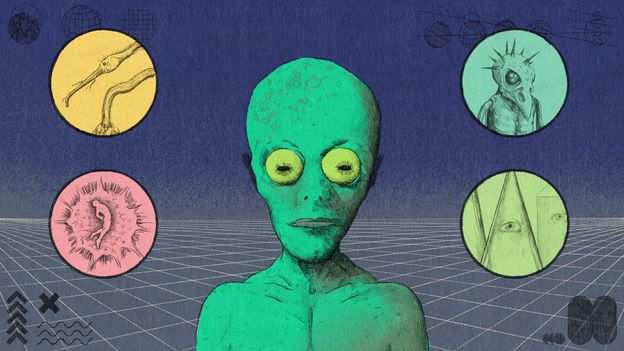The weird aliens of early science fiction – BBC.com
Humanity's ideas about aliens have been evolving for millennia – but in the era before television, they were considerably stranger.
In October 1961, Betty and Barney Hill sat down with an astronomy lecturer at their home in New Hampshire, and made an extraordinary claim. The previous month, the couple – a social worker and a postal service employee – had been driving along a winding road through the White Mountains, when they were snatched by a group of extraterrestrials, they said. The Hills explained that they had then been subjected to a series of invasive, "probing" examinations by these strange beings aboard a flying saucer-style spacecraft.
This article is part of a week special coverage about aliens – all to mark the upcoming 60th Anniversary of the BBC's most famous alien lifeform, Doctor Who.
The claims gripped the public imagination and are widely credited with pioneering the entire alien abduction genre – it was the first such story to be published, and led to many similar tales from members of the public. But it also contributed to another revolution – via Hollywood. In the Hills' account, the creatures they met had oversized heads with large craniums, wide eyes, greyish skin, small noses and slit-like mouths. The couple had invented the archetypal sci-fi movie alien – with an aesthetic like creepy, distorted human babies.
Together with a handful of similar tales that emerged around the same time, big-headed alien beings were quickly embraced by TV shows and films, according to Wade Roush, a science and technology writer and the author of the book Extraterrestrials. "And the standard depiction of aliens at that point became the little grey man," he says. "So, when Steven Spielberg came along and made probably what are the two most influential movies about aliens – Close Encounters of the Third Kind [1977], and ET the Extra-Terrestrial [1982] – the aliens and those movies were both basically variations on the 1950s and 1960s little green or little grey man image."
But what were depictions of extraterrestrials like before this collective tuning of the public imagination? And what has influenced the way we view them? Generations before, the aliens of early science fiction were considerably more fantastical – bloodcurdling octopus-beings, intelligent swarms of insect-creatures and monstrous reptiles.
A radical shift
In 1887 – before the invention of sliced bread, ice lollies or even the word "teenager" – the science fiction author Joseph Henri Honoré Boex set pen to paper in his Brussels office and imagined up Les Xipéhuz.
The book is set on Earth, a thousand years before the ancient Mesopotamian cities of Nineveh and Babylon were founded, and begins with a dream-like encounter in a forest clearing. A nomadic tribe of people are looking for somewhere to rest one night, but instead they stumble upon "Les Xipéhuz", translated as "The Shapes".
The bizarre, geometric creatures resembled "bluish, transparent cones" with their point facing upwards. Each was around half the size of a human, with some stripey markings and "a dazzling star near its base like the sun at midday". The creatures are considered among the first non-humanoid aliens in science fiction, within a cautionary tale that shows how devastating first contact can be with an unfamiliar "other". After many battles, (spoiler alert), it becomes clear that there's no room for diplomacy. Even the way the Shapes communicate, by tracing symbols on each other's bodies using the rays of their stars, is alien. In the end, they are exterminated.
As it happens, the timing of this story is no accident.
A dull beginning
Humanity has been contemplating the possibility of life on other planets for thousands of years. After an intensive, career-spanning observation of the skies, around 450 BC the ancient Greek philosopher Anaxagoras tentatively suggested that the Moon might not be a god, as was widely believed, but a rock like the Earth. In fact, he supposed, it might even contain life.
Anaxagoras was promptly sentenced to death for his insubordination – but the idea that there might be other celestial bodies like our own planet persisted. Decades later, the philosopher Democritus came to a similar conclusion after theorising that matter in the Universe might be made of tiny particles called atoms. "And that led to speculation that, you know, if there were an infinite number of atoms, then maybe there were an infinite number of other planets," says Roush.
But though speculation about life on other worlds is ancient, the extraterrestrials of these early musings were not like the imaginative creations found in books and on television today. "When people thought about aliens, I'm afraid they pretty much assumed that if there were aliens, they would look just like us, right? That intelligent, sentient animals would basically be humans," says Roush.
After all, at the time, what else could you expect? Roush explains that no one had really contemplated where humans came from or how we are related to other species – so there wasn't much scope for imagining rational beings beyond ourselves. "You see that reflected to some extent, even in religious symbology and mythology," he says. From the ancient Egyptian deity Hathor to the Roman goddess Minerva, most religious entities had at least some human characteristics.
But this all changed in 1859, when a leaf-green book with gold lettering first appeared on the shelves of intellectuals around the world. This was Charles Darwin's On the Origin of Species by Means of Natural Selection – and its impact on science fiction was as great as its influence on biology. "Then I think that our imaginations about the form that aliens might take started to range much more broadly," says Roush.
A peculiar menagerie
First there were the geometric creatures in Les Xipéhuz. But these were soon followed by a diversity of strange lifeforms to rival those on Earth itself. By the time The War of the Worlds was published in 1898, aliens were beginning to get truly monstrous. In this novel, H G Wells introduced readers to Martians – creatures consisting of a giant disembodied head with a beak-like mouth surrounded by tentacles. They reproduced asexually, and survived on a diet of fresh human blood which they extracted with pipettes – then injected into their bodies.
"They're a little bit like insects, they're a little bit like octopuses, a little bit like crabs. And so you get sort of very creepy, non-human shaped aliens starting in the 19th Century. Because people have finally kind of stumbled on the idea that evolution is a thing, and that it might take very different directions [elsewhere in the universe] than on our planet," says Roush.
Over the following decades, this menagerie of science-fiction aliens continued to flourish in literature. There were the insect-like Selenites of First Men in the Moon (1901), the flamingo-like Tweel in A Martian Odyssey (1934) – complete with a kind of strange beaky trunk – and even a bewilderingly dazzling sentient star in Star Maker (1937).
Our ideas about aliens were transformed again by the rise of Hollywood in the 20th Century, leading to on-screen extraterrestrials that were eerily human-like.
"I think the main reason for that actually is it's easier to just put a costume on a human than to come up with some really, very evolutionarily distant depiction – it's much easier to put a man in an alien suit, and have him walk around on his two legs with his two arms than it is to dream up some kind of, half-squid, half-insect," says Roush. And so, with inspiration from people like the Hills, aliens that walked on two legs and occupied an uncanny valley between humanity and something "other", became the standard. "Even on shows like Star Trek, right, almost all the aliens are humanoid, and it's clearly for budgetary reasons," says Roush.
However, in recent decades, new technologies have transformed what is possible. With computer-generated imagery from ever-more powerful processors – and now the advent of artificial intelligence – Roush thinks things have started to take a turn for the bizarre again. One example is the film Arrival, in which Earth is visited by ultra-sentient, space-faring aliens with seven legs: Heptapods. "With these amazing appendages that can squirt ink in order to communicate, they're really quite different," he says. "We can just make up 3D monsters and aliens that may never exist physically."
Who knows what science fiction will dream up next – it might even be weirder than what we actually find on other planets…
—
If you liked this story, sign up for The Essential List newsletter – a handpicked selection of features, videos and can't-miss news delivered to your inbox every Friday.
Join one million Future fans by liking us on Facebook, or follow us on Twitter or Instagram.
Some people can strike off on any journey with no guide except their 'pigeon senses'. How do they do it? And can this ability be learned?
Once grown almost solely by enslaved people, the fish pepper was nearly lost forever until a chance find in a freezer revived the plant and it's now more popular than ever.
Holocaust drama The Zone of Interest is chilling audiences – because of what they hear, not see. Sound designer Johnnie Burn discusses recreating the sounds of the concentration camp.
In the baffling world of skincare ingredients, where is the best place to start seeking sustainable skincare?
Marvel Entertainment has revealed the cast of the next Fantastic Four installment. Can this new cast turn things around for the formerly-flopped franchise?
Copyright 2024 BBC. All rights reserved. The BBC is not responsible for the content of external sites. Read about our approach to external linking.




 This year in odd news: The weirdest headlines from the Houston area in 2022 – KPRC Click2Houston
This year in odd news: The weirdest headlines from the Houston area in 2022 – KPRC Click2Houston 